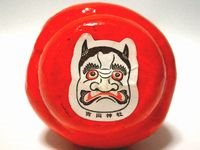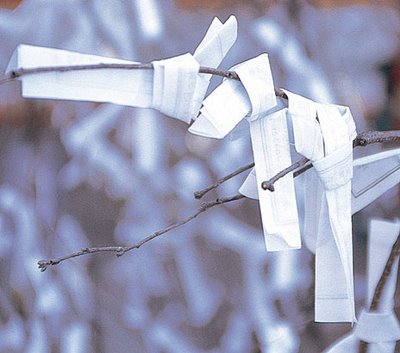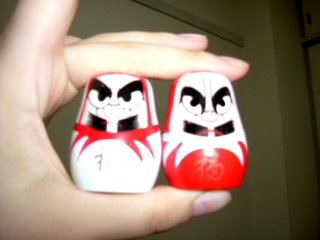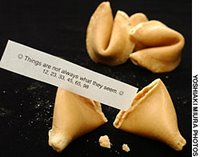[ . BACK to Worldkigo TOP . ]
:::::::::::::::::::::::::::::::::::::::::::::::::::::::::::::::::::::::::::::::::::::::::::::::::::::
Fortune-telling Daruma だるまみくじ 達磨御籤

Example from
. Yoshida Shrine 吉田神社 - Kyoto .
「だるまみくじ」の名前の通り、だるまの中におみくじが入っております。
The paper with the fortune telling text is hidden inside the small figure. You have to tear off the bottom paper to see your future.

(C) 2004 takashi okawa.
http://www11.ocn.ne.jp/~popyah/kyoto/darumamikuji.htm
One more big Daruma head from Yoshida
 © PHOTO : ttomo115
© PHOTO : ttomo115
:::::::::::::::::::::::::::::::::::::::::::::::::::::::::::::::::::::::::::::::::::::::::::::::::::::
Mikuji, O-Mikuji 御御籤/御神籤
(sacred lots)
Generally known as
o-mikuji, these messages written on a thin piece of washi, replies from Shinto or Buddhist deities, are used to tell the fortunes of those who visit shrines or temples with their problems. The visitor draws a numbered stick from the small opening at one end of a prism-shaped container and exchanges the stick for a mikuji of the corresponding number.

If the fortune is less than favorable, the visitor customarily ties the mikuji around a tree branch or in a designated location near the temple or shrine in hope that circumstances will eventually improve.
© Copyright. 1997
Kansai International Public Relations Promotion Office.
http://www.kippo.or.jp/culture_e/washi/daily/07.htm
:::::::::::::::::::::::::::::::::::::::::::::::::::::::::::::::::::::::::::::::::::::::::::::::::::::
The Daruma Mikuji also come as small wooden figures.
This one is from Temple Manpuku-Ji.
萬福寺・だるまおみくじ
 http://circle.kyoto-wu.ac.jp/kobiken/sinkan3.html
http://circle.kyoto-wu.ac.jp/kobiken/sinkan3.html
:::::::::::::::::::::::::::::::::::::::::::::::::::::::::::::::::::::::::::::::::::::::::::::::::::::
More about the Mikuji Daruma at Fuku-Ura, Matsushima
:::::::::::::::::::::::::::::::::::::::::::::::::::::::::::::::::::::::::::::::::::::::::::::::::::::
Daruma mikuji at the temple Kannon-Ji
 They are sold in a little basket
They are sold in a little basket
 source : marine1365
Temple Kannon-Ji HP
source : marine1365
Temple Kannon-Ji HP
In Tamba, famous for its hydrangea, ajisai.
:::::::::::::::::::::::::::::::::::::::::::::::::::::::::::::::::::::::::::::::::::::::::::::::::::::
The American version, fortune cookies !
This is a non-seasonal topic for haiku too.
fortune cookies
in the Sushi Bar
a Chinese treat
© The Japan Times: Sunday, April 16, 2006
What's really 'Chinese' about fortune cookies?
By ERIC PRIDEAUX
Try this for fun next time you're in New York City: Walk into any sushi bar, eat your fill and then ask for a fortune cookie.
"Would that be a Chinese fortune cookie?" the waiter will likely respond a little loftily. "Sorry, but this is a Japanese restaurant."
 "Exactly!" you might vouchsafe -- then launch into telling him how the so-called "Chinese" fortune cookie, that ubiquitous American snack that accompanies every order of General Tso's Chicken or Egg Foo Young, most probably came from . . . Japan, where near-identical tidbits called tsujiura sembei (crossroads-fortune crackers) have been enjoyed for generations. "Exactly!" you might vouchsafe -- then launch into telling him how the so-called "Chinese" fortune cookie, that ubiquitous American snack that accompanies every order of General Tso's Chicken or Egg Foo Young, most probably came from . . . Japan, where near-identical tidbits called tsujiura sembei (crossroads-fortune crackers) have been enjoyed for generations.
"They've got the same origin," said Yasuko Nakamachi, a Japanese folklore and history researcher at Kanagawa University who is the country's leading authority on tsujiura sembei. "Since this was a product transmitted from Japan, the [tsujiura sembei] and the American fortune cookie are the same."
Countless romances
Shaped like an orchid in bloom, and with a sagacious maxim printed on a slip of paper inside, the fortune cookie plays a bigger role in the scheme of occidental life than its tiny size would suggest.
For sure, countless romances have hinged on the aphorisms served up with them, running the gamut from the likes of "Go for it!" to "Celibacy is best." (One is even said to have warned, "Your date has herpes.")
And then there was a much-reported lottery early last year, in which more than 100 people across the United States who had played numbers printed on cookie fortunes apparently won in excess of $ 100,000 each.
But as life-changing as it seems they may be -- and fortune cookies these days can be found working their tasty magic in the likes of Britain and France as well -- where did they really originate?
Some amateur historians maintain that in the 19th century, Chinese workers in the American West celebrated the autumn Moon Festival by exchanging treats stuffed with cheerful messages -- a rough adaptation of traditional Chinese moon cakes. That theory, though, seems a bit of a stretch: Whereas fortune cookies are delicate and crunchy, moon cakes are soft, round and filled with bean paste.
Instead, gastronomic sleuths would probably do better to check out Baron Makoto Hagiwara, a Japanese aristocrat who, according to family tradition, was kidnapped from his homeland by pirates and taken to the United States.
According to Hagiwara's great-great-grandson, 48-year-old California landscape designer Erik S. Hagiwara-Nagata, his forebear decided to stay on in America, where, with money sent from Japan, he built the first authentic Japanese garden in San Francisco. There, he is said to have offered visitors another New World first: fortune cookies.
That was back around 1910, and though Hagiwara may have been the brains, it was the Baron's partner, Suyeichi Okamura, who was the brawn in the bakery behind those historic first batches. That, at least, is how Okamura's grandson, Los Angeles resident Gary T. Ono, explained it in an e-mail to The Japan Times, adding that his grandfather arrived in the U.S. from Kagoshima Prefecture in Kyushu in 1906, and went on to run the Benkyodo Candy Factory there. Indeed, Ono says, he has inherited baking irons identical to ones shown in some Meiji Era (1868-1912) woodblock prints.
Historical import
In addition, he relates an interesting story passed down through his family. It tells of a scene in a Chinese restaurant in San Francisco in the 1920s, when a Chinese man spotted a Japanese-American girl and her friends giggling over the slips of paper drawn from fortune cookies brought in a bag from Japan Town.
The man, it seems, asked what all the giggling was about, so they showed him the cookies. Not long after, one of the girls spotted the same man leaving a confectionery shop in Japan Town -- carrying a bag of fortune cookies. Canton-born David Jung, a baker and restaurateur in Los Angeles, is said to have begun making cookies containing paper messages around that time -- though, of course, no one can say he was the man in the restaurant.
Whatever the historical import of this tale, it begs the question why no one thought to patent the product. Those times, though, were different. "Business back then was done on a handshake," Erik Hagiwara-Nagata said in a phone interview.
What's more, Hagiwara and Okamura may have been reluctant to claim credit for a product with ancient roots in Japan.
According to "Divinatory, Apotropaic and Fortunate Confectionery," a short history with a long name by Japanese confection maker Toraya, the term tsujiura refers to a method of predicting the future based on the flow of pedestrians at road crossings. It was, apparently, mentioned by chroniclers as long ago as the early Heian Period (794-1185).
Later, snacks containing tsujiura fortunes are referred to in Edo (1603-1867) humorist Tamenaga Shunsui's (1790-1843) fictional work "Haru no wakagusa (The Young Grass of Spring)," in which a mischievous character named Mamehachi tries to placate a pair of women with tsujiura sembei, which are described as being brittle and containing fortunes.
 At around the same time, according to the Toraya history book, tsujiura cookies were being swooned over by prostitutes in Edo -- who might well have been yearning for true love to whisk them away from their station in life. Meanwhile, a woodblock print from 1868 that appears in the same book depicts a store selling tsujiura sembei. At around the same time, according to the Toraya history book, tsujiura cookies were being swooned over by prostitutes in Edo -- who might well have been yearning for true love to whisk them away from their station in life. Meanwhile, a woodblock print from 1868 that appears in the same book depicts a store selling tsujiura sembei.
The cookie pops up, too, in notes by Edward Morse (1838-1925), an American zoologist visiting Japan who described tsujiura sembei in an 1883 Japanese publication as being crisp, sweetened with molasses and "tasting like ginger snaps without the ginger." Sure enough, they had maxims stuffed inside.
Nonetheless, exactly why or how people like California baker Okamura came to reinvent tsujiura sembei as fortune cookies remains a mystery.
However, confectioner Takeshi Matsuhisa, 30, has no doubt the cookie's distinctive shape is homegrown. He has been told, he says, that virtually identical nibbles were common in the countryside when his grandfather Kihachi opened the family's Kyoto bakery early in the 1920s. Cookies sold at the shop today have changed little in form. "The fortune cookie," Matsuhisa confidently asserts, "is based on the Japanese model."
So, there you have it: a revisionist history of the Japanese fortune cookie.
Still in the mood for some erudite mischief? Go visit a Chinese restaurant and ask for ketchup. But that story will have to wait until another time.
The Japan Times: Sunday, April 16, 2006
http://search.japantimes.co.jp/cgi-bin/fl20060416x3.html
|
Young widow
Asks for another
fortune cookie
George Swede
http://www.millikin.edu/haiku/writerprofiles/GeorgeSwede.html
xxxxxxxxxxxxxxxxxxxxxxxxxxxxx
> > fortune cookie - -
> > her source of inspiration
> > finally revealed
(c) bill lerz
http://haiku.cc.ehime-u.ac.jp/shiki.archive/9805/1105.html
:::::::::::::::::::::::::::::::::::::::::::::::::::::::::::::::::::::::::::::::::::::::::::::::::::::
There is even a recipe for Haiku Fortune Cookies!
"Haikookies" are fortune cookie-type cookies.
"Type 24 haiku onto thin strips of paper. You can use the haiku from the books suggested below, or write your own haiku: three lines long, with the first line 5 syllables, the second line 7 syllables, and the third line 5 again. Put the haiku aside until later.
Next use
3 egg whites
1/2 cup white sugar
1/4 cup brown sugar
1/2 cup cake flour
1/2 teaspoon vanilla
And read the rest here, from Susan Branch's scrumptious cookbook Vineyard Seasons:
http://www.planetesme.com/fortunecookie.html
And one more LINK to these cookies by Alexis M. Iffert
For my haiku project, I decided to make fortune cookies and cleverly insert my haiku inside of them.
http://www.millikin.edu/haiku/studentprojects/IffertsFortuneCookies.html
:::::::::::::::::::::::::::::::::::::::::::::::::::::::::::::::::::::::::::::::::::::::::::::::::::::
mi-no-ue ya mikuji o hikeba aki no kaze
thus is my fate -
drawing divine lots
wind of autumn
Masaoka Shiki at Temple Ishite-Ji
:::::::::::::::::::::::::::::::::::::::::::::::::::::::::::::::::::::::::::::::::::::::::::::::::::::
Green Mikuji Daruma Dolls
 CLICK for many more photos !
CLICK for many more photos !
:::::::::::::::::::::::::::::::::::::::::::::::::::::::::::::::::::::::::::::::::::::::::::::::::::::
The temple 三宝寺 in Kyoto has about 325 of these wooden dolls in its precincts, maybe the ones with a bad fortune telling slip in them. The priest of the temple cleans them once a year and puts them on the shelf above the well.

みくじダルマ325個“居残る” 右京の三宝寺 運勢が意に沿わなかったのか
source : kakeiken.clipp.in August 2008 Kyoto Shinbun
:::::::::::::::::::::::::::::::::::::::::::::::::::::::::::::::::::::::::::::::::::::::::::::::::::::
:::::::::::::::::::::::::::::::::::::::::::::::::::::::::::::::::::::::::::::::::::::::::::::::::::::
. hatsu mikuji 初神籤(はつみくじ)first fortune-telling
observance kigo for the New Year
 からくりの巫女ささげくる初御籤
からくりの巫女ささげくる初御籤
karakuri no miko sasagekuru hatsu mikuji
the mechanical puppet
of a shrine maiden hands me
the first fortune-telling lot
Nagareboshi 流星
http://mariko789.exblog.jp/13666457/
.................................................................................
. mikuji ubai 御籤奪(みくじうばい)
fighting for the sacred lots
kigo for mid-winter
during the shrine festival at Miho Jinja 美保神社 in Izumo.
morotabune no shinji 諸手船神事 Morotabune Ritual
:::::::::::::::::::::::::::::::::::::::::::::::::::::::::::::::::::::::::::::::::::::::::::::::::::::
fortune cookie
on my New Year dinner plate:
don't ask, don't tell
New Year's fortune
cookie reads Be Happy!
bird droppings
Chen-ou Liu, Canada, 2011
:::::::::::::::::::::::::::::::::::::::::::::::::::::::::::::::::::::::::::::::::::::::::::::::::::::
a fortune teller
beside the street -
does he know himself?
Sunil Uniyal
India, 2011
..........................................................................
spring brings
memories of the temple verandah
and the omikuji
Angelee Deodhar
India, 2013
:::::::::::::::::::::::::::::::::::::::::::::::::::::::::::::::::::::::::::::::::::::::::::::::::::::

koi mikuji 恋みくじ lots for luck in love

Tokyo, Shrine Daijingu 大神宮 東京
source : www.tokyodaijingu.or.jp
- MORE - mikuji for love -
:::::::::::::::::::::::::::::::::::::::::::::::::::::::::::::::::::::::::::::::::::::::::::::::::::::
. Tengupedia - 天狗ペディア - Tengu ABC-List.
tengu no mikuji 天狗のみくじ Mikuji with Tengu



:::::::::::::::::::::::::::::::::::::::::::::::::::::::::::::::::::::::::::::::::::::::::::::::::::::
. Futomani 太占 divination .
. mikuji hato みくじ鳩 dove with a fortune-telling lot . - Usa Hachiman Shrine, Oita
. Sankaku mikuji 三角じくじ mikuji with three corners .
Wake Jinja 和気神社 Okayama
. WASHOKU
Moon cakes, Chinese mooncakes 月餅 (geppei)
. Amulets and Talismans from Japan .
[ . BACK to WORLDKIGO . TOP . ]
[ . BACK to DARUMA MUSEUM TOP . ]
:::::::::::::::::::::::::::::::::::::::::::::::::::::::::::::::::::::::::::::::::::::::::::::::::::::

























9 comments:
omikuji senbei ?
あまり聞きませんねえ。
でもとても面白い発想です。
すこぶる感心しました。
こんな事知っているGabi さんにも感心します。
sakuo
fortune inside a dyed Easter egg is a "big yoke"
hehehehe
WOWWWWWW Gabi san, you can find the most interesting articles...
THANX
ai... chibi
http://groups.yahoo.com/group/happyhaiku/
......................................................................
Fortune cookie
telling the poet
he’ll become one.
Zhanna P. Rader :)
choosing
watermelon slices
a fly and I
His fortune might be my misfortune ... but am I reading more into the topic than I need to? If a fly could pick a fortune cookie, what would it expect? (A bit of Lao Tzu here ...)
summer wind
blowing east then west
long way home
summer rain
a blackbird eats
the only peach
And there go our dreams of a 'bountiful' harvest this year.
fortune slip
I leave the cookie
uneaten
:>) Ella
Thanks Ella, for your uneaten cookie !
GABI
扇子型のおみくじ sacred lot in the form of a folding fan
Hakusan Guu 白山宮足王社 Hakusan shrine, Ehime
uranai 占い fortune telling, divination
The people of Edo were very fond of fortune telling of all kinds.
More about uranai in Edo !
.
http://edoflourishing.blogspot.jp/2016/05/uranai-fortune-telling.html
.
Ueno Tenmangu 上野天満宮 - omikuji おみくじ 天神 sacred lots
Sugawara Michizane holding Mikuji
.
https://omamorifromjapan.blogspot.jp/2011/07/tenjin-sama.html
.
gashapon Daruma だるまのガチャポン
gashapon Daruma mikuji fortune-telling sacred lots
だるまのガチャポン「だるみくじ」
.
The terms gashapon (ガシャポン) or gachapon (ガチャポン) refer to a variety of vending machine-dispensed capsule toys popular in Japan and elsewhere.
.
https://omamorifromjapan.blogspot.com/2018/11/gashapon-capsule-toys.html
.
Post a Comment